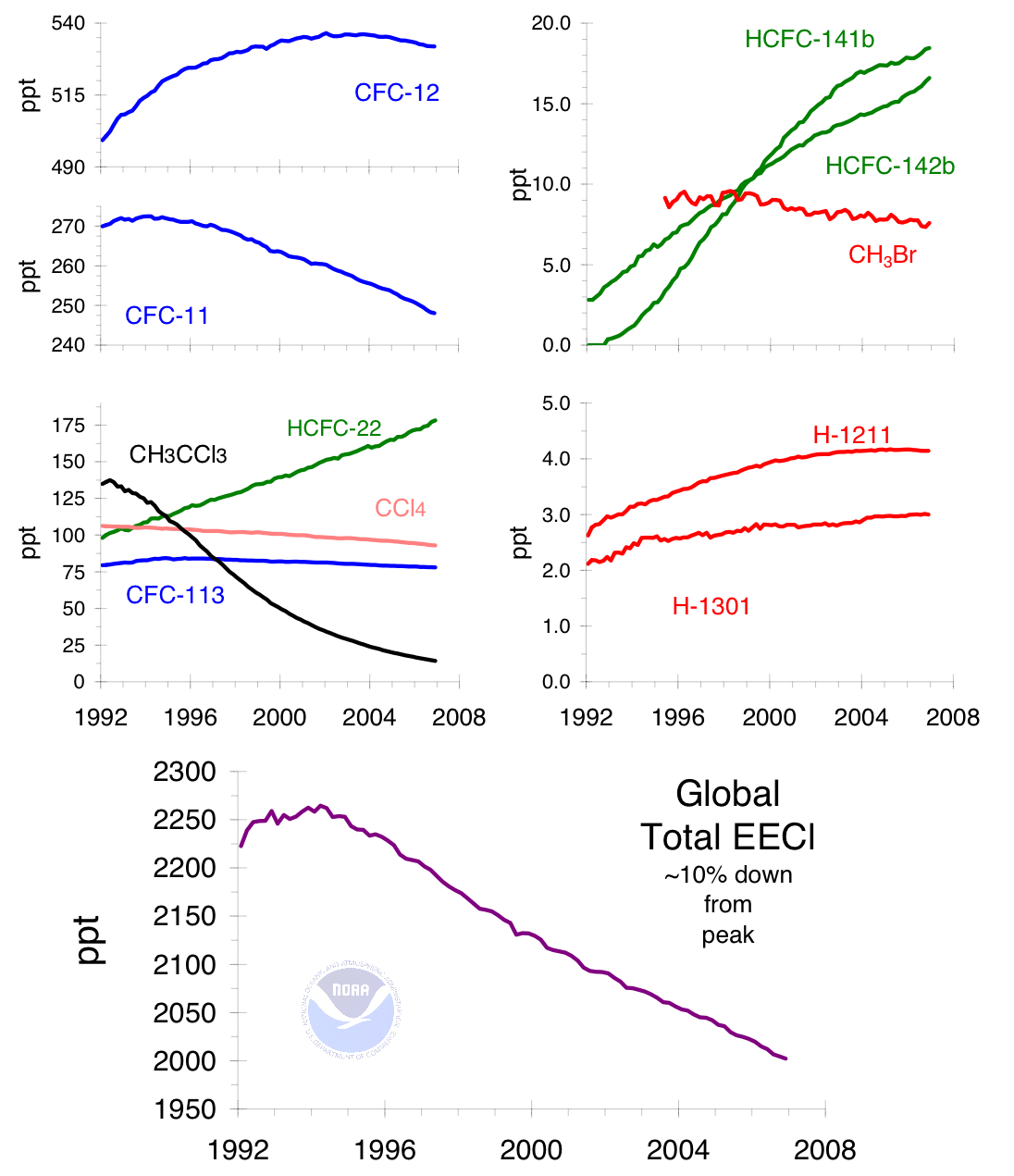Since 1989, when the treaty came into effect, there have been no attributable:
- massive job losses
- transfers of wealth from rich countries to the developing world
- One World Government run by the UN
- take-over by international socialists and their grant-tamed scientific elite.
Nor has the wheels fallen off the science. Rather there has been nine revisions signed; a dramatic reduction in the amount of CFCs and HCFCs released; and a leveling off or reductions in atmospheric concentrations of these substances; a new industry for ozone-friendly refrigerants and aerosol propellants, and most importantly, this year's Antarctic ozone hole appears likely to level out below the worst 2006 benchmark. This confirms predictions that repair is likely, though distant.
So we see Copenhagen can work; we have proof in precedents — we just need the will.





6 comments:
First, this posting is a perfect example of the broken window fallacy. Sadly, few in the progressive camps on both the left and right seem to be familiar with it. Getting rid of freon did have a clear effect on the economy. By getting rid of a cheap, safe, and efficient material and using a patent protected substitute that was not as efficient or safe our refrigeration operations cost us more and use more energy. The chemical companies that were able to sell the new more expensive substitute saw their margins increase while consumers were forced to pay more for something that did less.
But let us ignore the economics and look at the ozone hole that the treaty was supposed to 'save.' Not too long ago (2006) we saw a record size for the Antarctic ozone hole, which means that the treaty did not do what it was supposed to because it was very unlikely that freon had little to do with ozone to begin with.
http://www.nasa.gov/vision/earth/lookingatearth/ozone_record.html
http://earthobservatory.nasa.gov/IOTD/view.php?id=7044
The greens would be far more credible if they refrained from pushing natural variation as evidence of effectiveness. In case you missed it sentiment around the globe is turning and voters are upset about being lied to.
Almost every your up until 2006 we saw a record year VangelV, then the records stopped.
What does that tell you? The evidence is strong that international environmental treaties work.
Almost every your up until 2006 we saw a record year VangelV, then the records stopped.
What does that tell you? The evidence is strong that international environmental treaties work.
It is telling me that you are confusing natural variation with man-made trends. As long as solar activity is on the wane and UV output declines we would expect to see a shrinkage of the ozone hole. When it picks up again we will see the hole expand.
I suppose you have a reference to peer-reviews literature establishing the size of the ozone hole is related to the solar cycle?
Then again I suppose not.
I suppose you have a reference to peer-reviews literature establishing the size of the ozone hole is related to the solar cycle?
Go back to basic physics of ozone formation.
http://www.atmosphere.mpg.de/enid/m2.html
In the stratosphere, the O-O bond in the normal O2 molecule is split by a photon from the ultraviolet spectrum. Some of the O atoms react with each other to form O2. Others react with O2 molecules to form O3, which is oznone. If you look at the literature you will find that the ozone hole gets much bigger every winter as would be expected when there is less UV radiation striking the polar region and there is less O3 formation.
As I pointed out above, the record high measurement for the size of the ozone hole came in 2006 quite a long time after freon was eliminated and we started to use more dangerous and more expensive chemicals as refrigerants.
I find it ironic that the so-called environmentalists supported the use of a less efficient refrigerant, which means that we are spending much more energy to do the same thing as we would have if we used the proven off-patent freon. While the ban did nothing for the ozone hole it certainly helped Dow and the other chemical companies that were able to score much higher margins thanks to the switch to the less stable, less efficient alternative. The same thing is happening now as the green lobby is helping to fatten the bottom lines of industries that benefit from various regulations, subsidies and barriers. Why not help GE make more money by forcing a switch to compact fluorescent light bulbs, which contain dangerous mercury, burn out faster than advertised, and are made off shore? Why not push electric vehicles and wind turbines even though the supply of the essential REEs (required to make them work) is primarily controlled by China, which has 90% of global production? While the push will make investors in GE and Nissan happy, I doubt that ordinary people, who see their costs explode will be pleased.
Stupid moves such as banning DDT and freon, and supporting the AGW myth is harming the conservation movement, which used to actually be interested in the environment way back in my day. Now the movement has been hijacked by anti-capitalist, anti-humanity lefties who seem to worship Malthus and see individuals as pawns in a political game. As nature fails to cooperate and the harm of the mindless policies promoted by the movement become better known, the environmentalists will become a fringe cult that few take seriously. Humanity will be better for it. I just hope that the backlash does not do harm to the environment that so many of us care about.
You told him!
Post a Comment